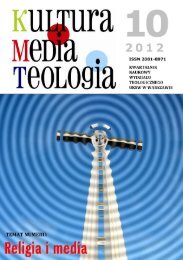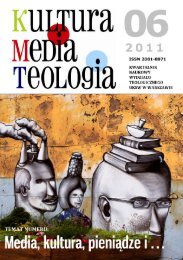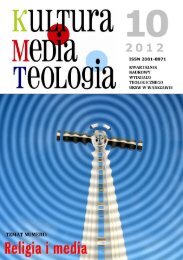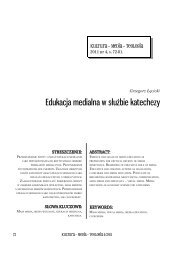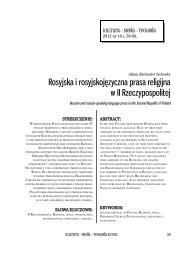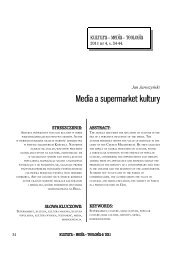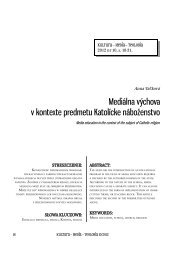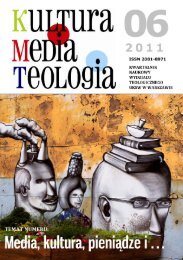Ilustracja 2: - Kultura - Media - Teologia
Ilustracja 2: - Kultura - Media - Teologia
Ilustracja 2: - Kultura - Media - Teologia
You also want an ePaper? Increase the reach of your titles
YUMPU automatically turns print PDFs into web optimized ePapers that Google loves.
P. Mikuláš, Global Patterns for National Stars?...<br />
to retain in other formats. Moreover, in both cases we can talk about determination of<br />
success by a chosen genre. Once the family occured in other genre than reality TV (Čo na<br />
to Mojsejovci? and Osbournes: Reloaded; both mutated talk shows), it had a very sub-<br />
-standard audience share, and were prematurely withdrawn from broadcast.<br />
Similarities can be also found at the level of individual family members. Similarly<br />
to Ozzy Osbourne, Braňo Mojsej is a music performer. However, Ozzy is a music legend,<br />
but Braňo is probably still waiting for his carreer turnover to come. Both men are<br />
financially guided by their wives, who are portrayed as more responsible and circumspect.<br />
With the high family budgets, both wifes ostentatiously displayed their affiliation<br />
to a higher social class via expensive purchases, aimed at the top class fashion.<br />
It is important to say that there are also many differences between the two families.<br />
Probably the biggest one lies in the fact that the Osbournes have children, while<br />
Mojsejs are childless. A presence of children in reality TV is certainly interesting interlocutor<br />
factor that can lead to interesting and attractive situations. From the narratological<br />
point of view, a complete family retells the story of a deep variety of interpersonal relationships.<br />
In this context, Osbournes have a significant advantage because of their<br />
three children, although just two of them featured in the show. From this viewpoint,<br />
Mojsejs had to portray other topics than the stereotypical stories of family harmony in<br />
its broadest meaning. At least at the level of acting in the reality TV, there are quite a lot<br />
of similarities between the two families. On this basis, the media representation of Mojsejs<br />
should be viewed as a response of domestic background to foreign inspirations.<br />
Pointing to a number of similarities between the Osbournes and Mojsejs doesn´t<br />
automaticly mean that the Slovak protagonists intentionally and purposely copied the<br />
U.S. ones. A more appropriate answer to the question stated in the introduction would<br />
be: despite a strong wave of criticism, Mojsejs as celebreality stars aren´t entirely original<br />
Slovak reality TV phenomenon, at least at the level of co-creators and innovators of<br />
reality TV formats. Acquired knowledge suggests that local media scenes of small countries<br />
like Slovakia have to be viewed in the broader context of global development<br />
trends. A comparison of Osbournes as a global reality TV stars with Mojsejs as local ones<br />
appears to be a good example of specific type of glocalization in media sphere. This kind<br />
of implicit globalization is a specific manifestation of contemporary media culture.■<br />
BIBLIOGRAPHY<br />
Andrejevic, Mark (2003): Reality TV: The Work of Being Watched. Lanham : Rowman<br />
& Littlefield Publishers, Inc. ISBN-10: 0742527484.<br />
Bočák, Michal – Rusnák, Juraj (2008): Na ceste za poslucháčom a divákom:<br />
Poznámky o trendoch v programovaní v elektronických médiách. [On the<br />
way towards radio and television audience: Notes on trends in program-<br />
<strong>Kultura</strong> – <strong>Media</strong> – <strong>Teologia</strong> 10/2012 113



